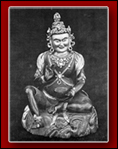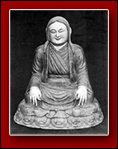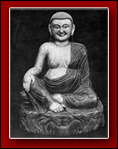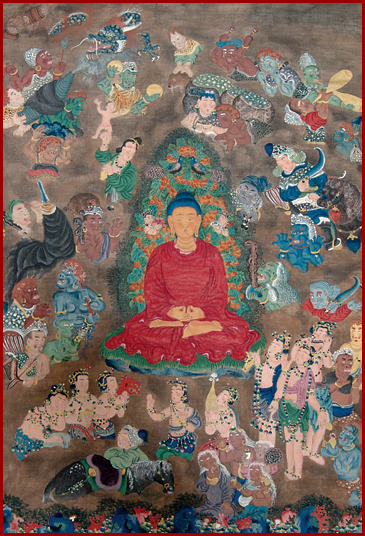 The Tenth Karmapa, Chöying Dorje (1604-1674), was among the most original artists in Tibetan history. Looking at his use of color and the treatment of human and animal figures, one would hardly guess that they were the creations of a 17th-century Tibetan artist, so fresh was his personal vision.
The Tenth Karmapa, Chöying Dorje (1604-1674), was among the most original artists in Tibetan history. Looking at his use of color and the treatment of human and animal figures, one would hardly guess that they were the creations of a 17th-century Tibetan artist, so fresh was his personal vision.
The life of the Tenth Karmapa offered many conditions for the latent artistic talent of the Karmapas to manifest fully. The Tenth Karmapa lived through a turbulent time that brought dramatic changes to the position of the Karma Kagyu in Tibet. The 17th century’s sectarianism resulted in the return of Mongol forces to Tibetan soil. In one terrible attack, the Karmapa’s entire Great Encampment was demolished, and its residents injured or killed. Only Chöying Dorje and an attendant managed to escape, and eventually made their way to the independent kingdom of Lijiang far to the east. For most of his adult lifetime, Chöying Dorje found himself bereft of the usual conditions for spreading the teachings of his lineage.  However, with the characteristic creativity and resolve of the Karmapa, Chöying Dorje was able to draw on his artistic ability to bring beauty and inspiration to the world. The Tenth Karmapa created at least one sacred image each and every day of his adult life, and presented most of them to others.
However, with the characteristic creativity and resolve of the Karmapa, Chöying Dorje was able to draw on his artistic ability to bring beauty and inspiration to the world. The Tenth Karmapa created at least one sacred image each and every day of his adult life, and presented most of them to others.
Chöying Dorje’s extraordinary paintings, as well as the statues pictured here, reveal this great master’s unique vision and his ability to manifest what he alone saw for that others to view as well. At the same time, Chöying Dorje’s art displays his responsiveness to many other forms, as he integrated elements ranging from Chinese landscape painting to Kashmiri sculptural styles. View some of Chöying Dorje’s paintings here, and his sculptures here.
 When he offered vows to yogic disciples, at the same time the Tenth Karmapa often presented them with images of Milarepa. To those students who committed to doing large numbers of recitation of the mani mantra, he generally offered one of his own drawings or paintings of Avalokiteśvara, the Buddha of Compassion.
When he offered vows to yogic disciples, at the same time the Tenth Karmapa often presented them with images of Milarepa. To those students who committed to doing large numbers of recitation of the mani mantra, he generally offered one of his own drawings or paintings of Avalokiteśvara, the Buddha of Compassion.
Whether produced while on the move as a refugee or while he was temporarily hosted by friendly territories in the border area between Tibet with China, the Tenth Karmapa’s artistic activities reflect a quiet constancy of purpose and an unflinching commitment to be a source of goodness and joy to the world.
|
|
|||
 The Tenth Karmapa, Chöying Dorje, among the most original artists in Tibetan history, painted this remarkable scene from the Buddha’s life story. On the verge of his enlightenment, Prince Siddhartha is seated beneath the Bodhi Tree. Though surrounded by the legions of obstacles and temptations he had to overcome in order to reach that point, depicted here in the form of demons and temptresses, the Buddha-to-be remains tranquil, his resolve to awaken utterly unshaken. Photo by Karl Debreczeny |
Contributions to Art, Culture and History THE UNIQUE ARTISTRY OF THE TENTH KARMAPA, CHÖYING DORJE
|
||


